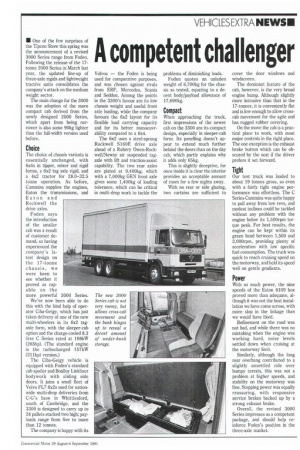A competent challenger
Page 11

If you've noticed an error in this article please click here to report it so we can fix it.
• One of the few surprises of the Tipcon Show this spring was the announcement of a revised 3000 Series range from Foden. Following the release of the 17tonne 2000 Series in March last year, the updated line-up of three-axle rigids and lightweight tractive units consolidates the company's attack on the medium weight sector.
The main change for the 3000 was the adoption of the more compact cab derived from the newly designed 2000 Series, which apart from being narrower is also some 90kg lighter than the full-width version used before.
Choice
The choice of chassis variants is essentially unchanged, with 6x4s in tipper, mixer and rigid forms, a 6x2 tag axle rigid, and a 4x2 tractor for 28.0-323 tonne operation. As before, Cummins supplies the engines, Eaton the transmissions, and Eaton and Rockwell the drive axles.
Foden says the introduction of the smaller cab was a result of customer demand, so having experienced the company's latest design on the I7-tonne chassis, we were keen to see whether it proved as capable on the more powerful 3000 Series.
We've now been able to do this with the kind help of operator Ciba-Geigy, which has just taken delivery of one of the new multi-wheelers in its 6x2 tagaxle form, with the sleeper-cab option and the charge-cooled 8.3 Litre C Series rated at 198kW (265hp). (The standard engine is the turbocharged 157kW (211hp) version.) The Ciba-Geigy vehicle is equipped with Foden's standard cab spoiler and Boalloy Linkliner bodywork with sliding side doors. It joins a small fleet of Volvo FL7 6x2s used for nationwide multi-drop deliveries from C-G's base in Whittlesford, south of Cambridge, and the 3300 is designed to carry up to 24 pallets stacked two high; payloads range from five to more than 12 tonnes.
The company is happy with its Volvos — the Foden is being used for comparative purposes, and was chosen against rivals from ERF, Mercedes, Scania and Seddon. Among the points in the 3300's favour are its low chassis weight and useful front axle loading, while the company favours the 6x2 layout for its flexible load carrying capacity and for its better manoeuvrability compared to a 6x4.
The 6x2 uses a steel-sprung Rockwell S160E drive axle ahead of a Rubery Owen-Rockwell/Neway air suspended tagaxle with lift and traction-assist capability. The two rear axles are plated at 9,400kg, which with a 7,000kg GKN front axle gives some 1,400kg of loading tolerance, which can be critical in multi-drop work to tackle the problems of diminishing loads.
Foden quotes an unladen weight of 6,700kg for the chassis as tested, equating to a decent body/payload allowance of 17,690kg.
Compact
When approaching the truck, first impressions of the newer cab on the 3300 are its compact design, especially in sleeper-cab form. Its panelling doesn't appear to extend much further behind the doors than on the day cab, which partly explains why it adds only 65kg.
This is slightly deceptive, for once inside it is clear the interior provides an acceptable amount of room for a few nights away.
With no rear or side glazing, two curtains are sufficient to cover the door windows and windscreen.
The dominant feature of the cab, however, is the very broad engine hump. Although slightly more intrusive than that in the 17-tonner, it is conveniently flat and is low enough to allow crosscab movement for the agile and has rugged rubber covering.
On the move the cab is a practical place to work, with most major controls in the right place. The one exception is the exhaust brake button which can be obscured by the seat if the driver prefers it set forward.
Tight
Our test truck was loaded to about 19 tonnes gross, so even with a fairly tight engine performance was effortless. The C Series Cummins was quite happy to pull away from low revs, and modest inclines could be tackled without any problem with the engine below its 1,500rpm torque peak. For best results, the engine can be kept within its green band between 1,500 and 2,000rpm, providing plenty of acceleration with low specific fuel consumption. The truck was quick to reach cruising speed on the motorway, and held its speed well on gentle gradients.
Power
With so much power, the nine speeds of the Eaton 6109 box proved more than adequate, although it was not the best installation we have come across, with more slop in the linkage than we would have liked.
Refinement on the road was not bad, and while there was no mistaking when the engine was working hard, noise levels settled down when cruising at the motorway limit.
Similarly, although the long rear overhang contributed to a slightly unsettled ride over bumpy terrain, this was not a problem at higher speeds, and stability on the motorway was fine. Stopping power was equally reassuring, with responsive service brakes backed up by a strong exhaust brake.
Overall, the revised 3000 Series impresses as a competent package, and should help reinforce Foden's position in the three-axle market.
















































































